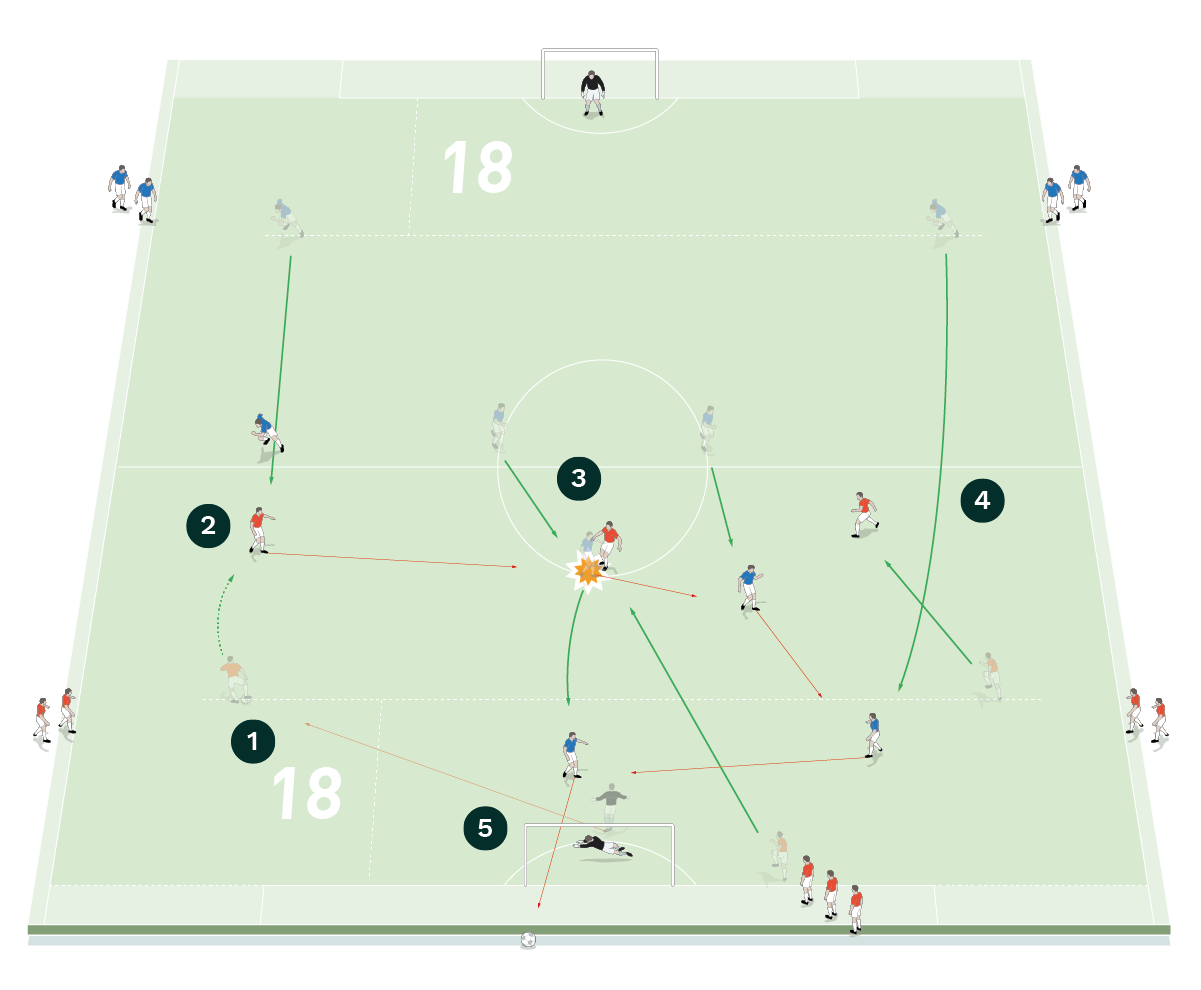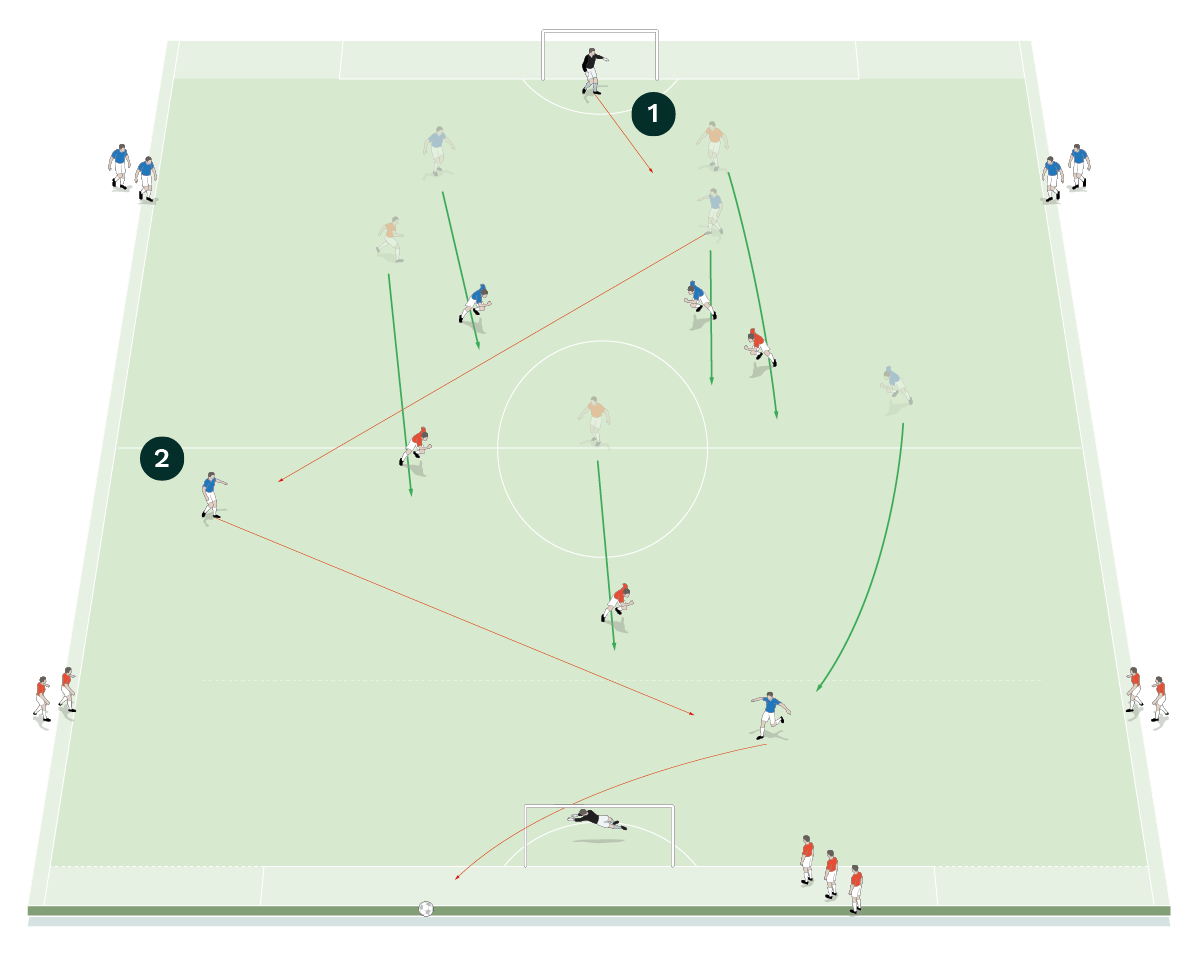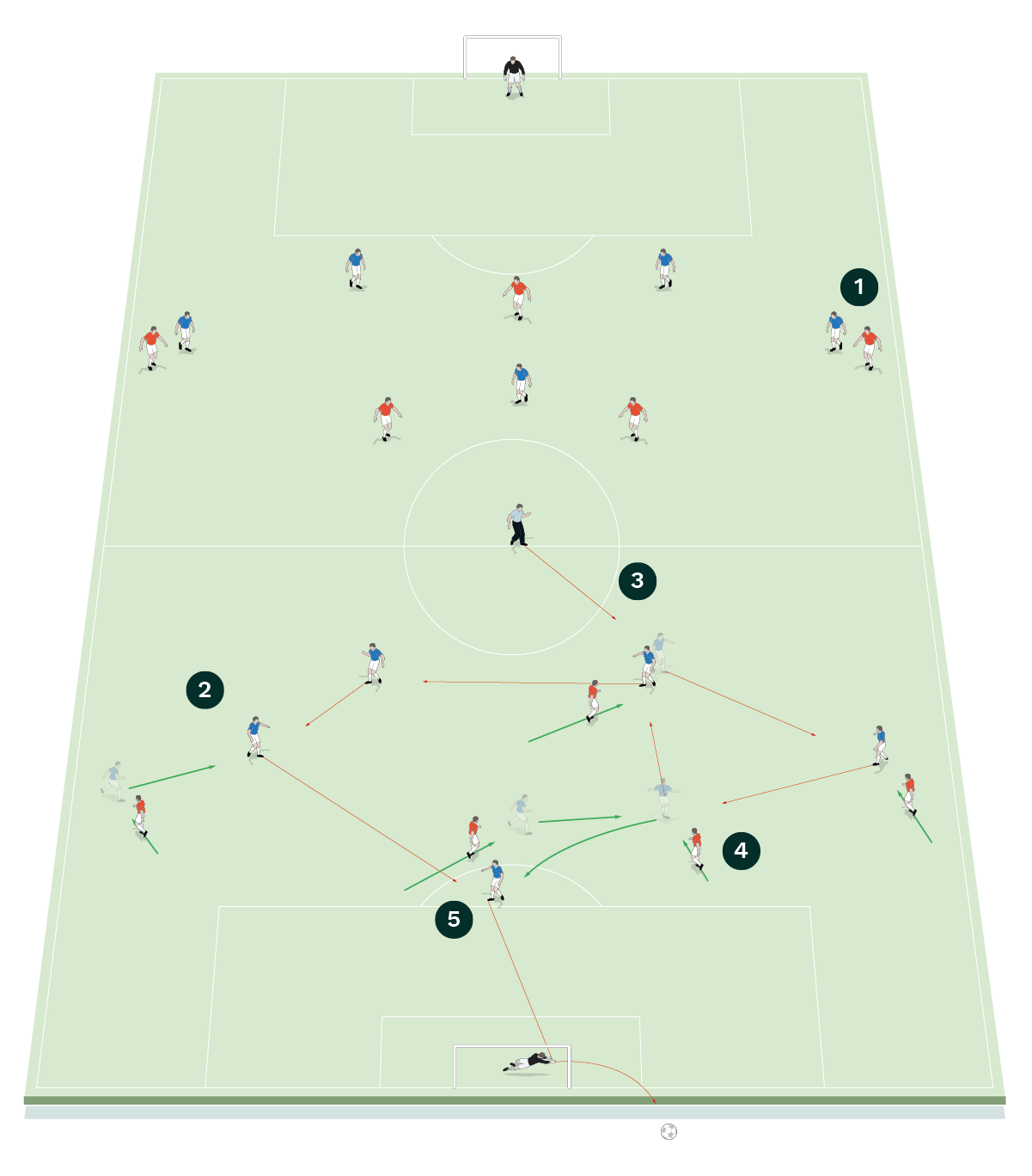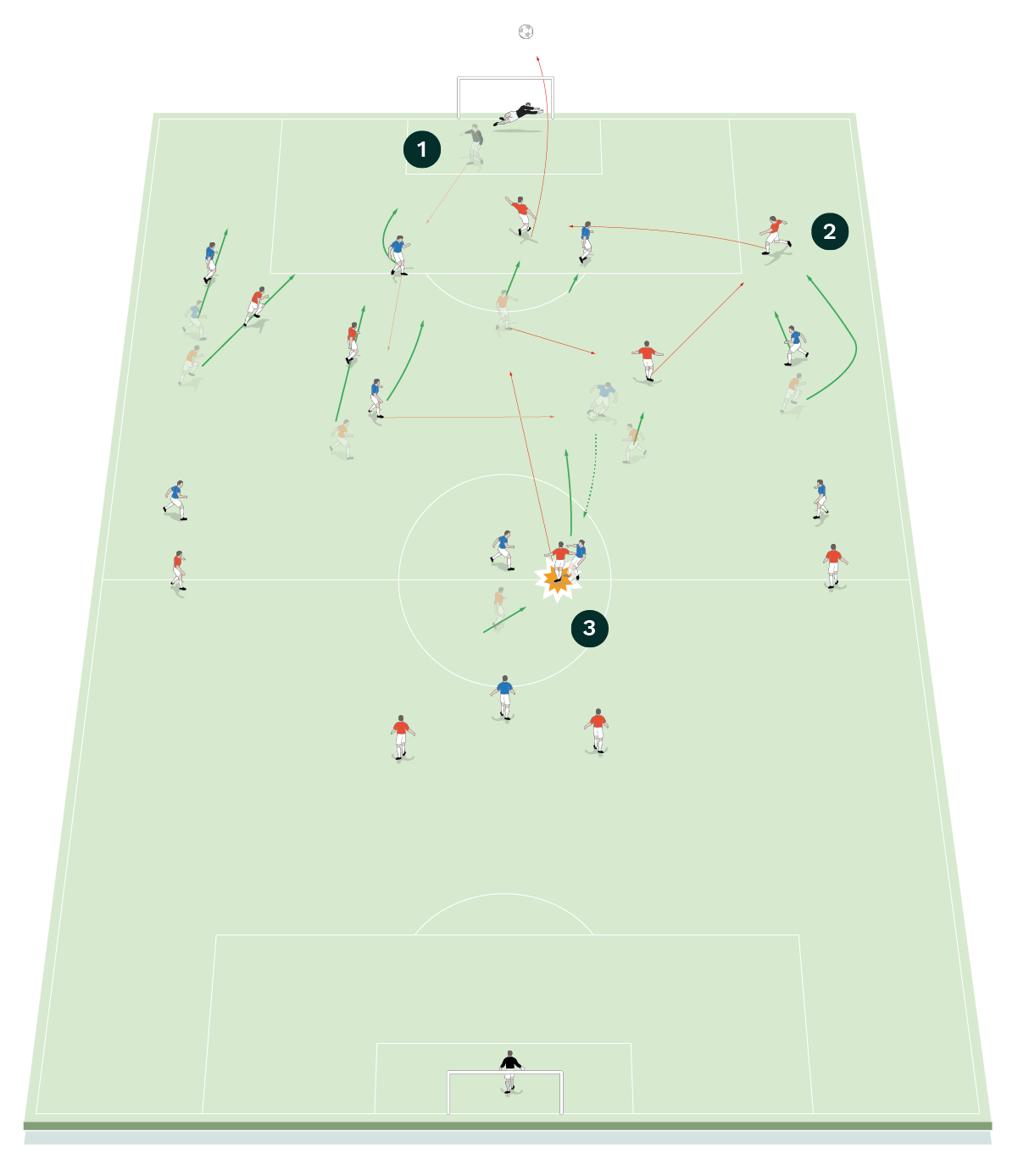You are viewing 1 of your 1 free articles
COUNTER-ATTACKING WITH SPEED
| Area | Up to full pitch |
| Equipment | Balls, bibs, cones, 2 full size goals |
| No. of Players | Up to 20 players + 2 goalkeepers |
| Session Time | Counter-attacking game: 15mins Game of two halves: 15mins 11v11 game: 30mins |
This session focuses on fast counter-attacking football when winning the ball. The moment a team regains possession, regardless of where on the pitch it happens, there is a very short window of opportunity to attack the opposition goal with the opponents unorganised and not in their “ideal” defensive organisation. Can we attack quickly and score? The decisions made by players immediately on regaining the ball are very important in order to stop opponents from counter-pressing and preventing an attack.
Players must always remember, a counter-attack is launched from anywhere on the pitch and must not be seen as a tactic used for teams defending with a low block or a deep starting position. Whenever a team regains the ball, wherever they are on the pitch, this is still a counter-attacking opportunity. The closer a team is to the opposition goal when they regain possession, the quicker they can get into a goal scoring position.
It is ideal to run this session early in the week as it will provide the players with both high physical outputs for total distance covered and also high intensity distances.
“A counter-attack is launched from anywhere on the pitch and must not be seen as a tactic used for teams defending with a low block”
COUNTER-ATTACKING GAME
We set up a playing area between the two penalty boxes, using the full width of the pitch. We position a full size goal and a goalkeeper at each end. We’re using 18 outfield players split into a team of eight blues and a team of 10 reds. The blue team sets up with a goalkeeper and four active players arranged in a 2-2 formation, with the two wider players positioned 18 yards into the playing area and the other two on the halfway line, as shown. The remaining blue players wait off the pitch for their turn to rotate in.
The red team sets up with a goalkeeper and three active players in a 1-2 formation, with one player starting next to the goal and the two other attackers positioned 18 yards into the playing area, as shown. The remaining red players stand off the pitch waiting to rotate in.
This is a counter-attacking game and the blue team defends 2v3 and attacks 4v3, while the red team attacks 3v2 and defends 3v4.
The red goalkeeper starts the game by rolling the ball out to a red attacker. The red team immediately attacks at top speed against the two central blues, making it 3v2. If the two blue players win possession, they are then joined by the two other blue players, making it a 4v3 counter-attack by the blues. The aim for the blue players is to score a counter-attacking goal, as shown [1a].
[1a]

- The red goalkeeper starts the game by rolling the ball out to a red attacker
- The three active red players immediately attack against the two central blues in a 3v2 and try to get past them to score a goal
- If the two central blue players win possession, they are joined by the two other blues, making it a 4v3 counter-attack
- Here a wide blue player makes a run to support the attack
If the blues score, the players reset and the red goalkeeper again starts play by rolling the ball out to a team mate. The red team attacks quickly with a 3v2 overload against the two central blues and they aim to make their overload count and combine to get past the defenders and score a goal, as shown [1b].
[1b]

- The players reset and the red goalkeeper again starts play by rolling the ball out to a team mate
- The red team attacks quickly with a 3v2 overload against the two central blues
- The reds combine to get past the blues and create a scoring opportunity
If the reds score, or shoot and miss, or if the keeper saves, the game then restarts from the blue goalkeeper, who immediately serves the ball to a team mate to launch a quick counter-attack, making the game 4v3 in the blue team’s favour as the blues attack the red goal again, as shown [1c].
[1c]

- If the reds score a goal, or if the shot is saved or missed, the blue keeper quickly serves the ball to a team mate and the blues launch a 4v3 counter-attack
- The blues use their 4v3 overload to get past the reds and set up a scoring opportunity
Each team stays in the same roles for five minutes, or for a set number of attacks, then the waiting players rotate into the game
The three red attackers leave the pitch and are replaced by three new red attackers. The two blue central player leave the pitch and are replaced by the two wide blues, while two new blue players come on and serve as two new wide blues.
GAME OF TWO HALVES
We set up on a full pitch with a goal at each end. We’re using 20 outfield players split evenly into two teams. Each team has five outfield players (a back four and a defensive central midfielder) and a goalkeeper locked in their defensive half of the pitch, and another five outfield players (two central midfielders, two wingers and a striker) locked in their attacking half, essentially creating a 5v5 in each half.
The coach starts play from the middle of the pitch by serving the ball to one of the blue central midfielders. The blue team immediately attacks with the aim of scoring, as shown [2a], while the reds try to defend their goal.
[2a]

- Each team has a back four and a defensive central midfielder locked in their defensive half of the pitch
- Each team has two central midfielders, two wingers and a striker locked in their attacking half
- The coach starts play by serving the ball to one of the blue central midfielders
- The red defenders try to stop the blues scoring
- The blue team immediately attacks with the aim of scoring
If a goal is scored, play restarts with the coach serving to a central midfielder again but if the opposition team wins the ball back in their own defensive half, they should counter-attack across the halfway line and try to create a scoring opportunity, as shown [2b].
[2b]

- The blue team immediately attacks with the aim of scoring
- If the opposition team wins the ball back in their own defensive half, they counter-attack. After winning the ball, this red drives forwards, isolating the blue defender by running at speed
- Here the reds attack across the halfway line and try to create a scoring opportunity
“If the opposition team wins the ball back in their own defensive half, they should counter-attack across the halfway line”
11v11 GAME
We set up on a full size pitch with a goal and a goalkeeper at each end. We’re using two full teams of 11 and we get the players to play a normal game. For the first ten minutes, the blue team is awarded every restart, as shown [3], and for the second ten minutes, the red team is awarded every restart. This allows the out-of-possession team to be coached to defend as a unit, regain the ball and quickly launch a counter-attack.
For the final ten minutes we impose no conditions, so restarts happen normally. Balls are placed around the pitch to allow for quick restarts. As a progression, the coach can also allow only a certain number of players to defend at points, in order to create overload situations.
[3]

- Here the blue goalkeeper restarts play by passing the ball out from the back. The blues are set up in a 4-5-1 formation and are allowed to take each restart of play for the first 10 minutes of this 11v11 game
- The reds are set up in a 4-3-3 formation and are allowed to take each restart for the second 10 minutes of the game
- If the red team wins the ball they must counter-attack to score a goal
COACHING POINTS
What are the key things to look for?
On regaining the ball, we want to see the player in possession pass forwards or drive forwards with the ball. Indeed, when an attacking situation arises with an overload, we want to see if the player in possession can try to isolate one specific defender by running with the ball at speed. Also, can their team mates make runs off the ball in order to get in front of the dribbling player with an overlap or underlapping run to give the player in possession a passing option.
At all times we want to see players using overloads to create 2v1 situations by picking on and isolating a specific defensive player
What are the typical mistakes players might make and how do I avoid them?
On regaining the ball, if the player in possession does not make a quick decision, then the opponents may counter-press quickly and steal back possession or quickly transition and run back into their defensive shape.
Related Files
Editor's Picks
Intensive boxes drill with goals
Penetrating the final third
Creating and finishing
My philosophy
Pressing initiation
Compact team movement
Defensive organisation
Back three tactics
Counter-pressing as an offensive weapon
Coaches' Testimonials

Alan Pardew

Arsène Wenger

Brendan Rodgers

Carlos Carvalhal

José Mourinho

Jürgen Klopp

Pep Guardiola

Roy Hodgson

Sir Alex Ferguson

Steven Gerrard
Related
Sunflower positioning
Possession in wide areas
Coaches' Testimonials

Gerald Kearney, Downtown Las Vegas Soccer Club

Paul Butler, Florida, USA

Rick Shields, Springboro, USA

Tony Green, Pierrefonds Titans, Quebec, Canada
Join the world's leading coaches and managers and discover for yourself one of the best kept secrets in coaching. No other training tool on the planet is written or read by the calibre of names you’ll find in Elite Soccer.
In a recent survey 92% of subscribers said Elite Soccer makes them more confident, 89% said it makes them a more effective coach and 91% said it makes them more inspired.
Get Monthly Inspiration
All the latest techniques and approaches
Since 2010 Elite Soccer has given subscribers exclusive insight into the training ground practices of the world’s best coaches. Published in partnership with the League Managers Association we have unparalleled access to the leading lights in the English leagues, as well as a host of international managers.
Elite Soccer exclusively features sessions written by the coaches themselves. There are no observed sessions and no sessions “in the style of”, just first-hand advice delivered direct to you from the coach.








